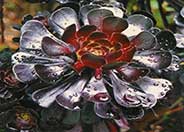
Common name:Torch Lily
Botanical name:Kniphofia hybrids
This perennial will grow to about 6' tall and has large green leaves with red, orange, and yellow flowers that bloom in spring, summer, and fall.

Common name:Japanese Blood Grass
Botanical name:Imperata cylindrica 'Rubra'
This groundcover/grass can reach up to 3' tall and has green leaves that are reddish maroon at the tips.

Common name:Pomegranate
Botanical name:Punica granatum
A dense growing shrub, the Pomegranate produces showy, orange red flowers that are followed by 2" diameter decorative fruit. Its apple green leaves are about 1" long and 1/2" wide. (The fruit is not edible.)

Common name:Aeonium
Botanical name:Aeonium arboreum 'Zwartkop'
Aeonium arboreum 'Zwartkop' is a succulent perennial that is used for accenting effect. Aeonium arboreum grows 3' tall and wide. Each branch has a 6"-8 " wide rosette of dark green, fleshy leaves.The flowers are yellow in clusters.

Common name:Hopseed Bush
Botanical name:Dodonaea viscosa
This small evergreen tree or shrub can grow up to 12'-15' high and 12' wide. Leaf color can vary from green to purple. It is a relatively short-lived tree, compared to most other trees. It is drought tolerant. It prefers full sun although it will tolerate part shade. It is susceptible to Texas root rot.

Common name:Mexican Bush Sage
Botanical name:Salvia leucantha
The Mexican Sage is a bushy shrub that grows 3'-4' tall and wide. It has hairy white stems, gray green leaves and velvet-like purple flower spikes that bloom summer through fall. This shrub tolerates sun, light shade, little water, and is hardy to 15 degrees F. The Mexican Sage is drought tolerant and attracts hummingbirds. -Cornflower Farms

Common name:Italian Cypress
Botanical name:Cupressus sempervirens 'Stricta'
Italian Cypress is often associated with Italian and Spanish architecture, providing columns in the landscape. They often reach 60' tall. 'Stricta' is compact, columnar and produces long, straight branches with deep green foliage.
Pest Management
Are pests bugging you? If pests are taking over there might be a good reason! Instead of grabbing that bottle of spray, consider using techniques that can solve your pest problems without toxic pesticides.
Click in the green box for more information
| Designer: | Colorful Poolside Planting |
Photographer: GardenSoft |
Soils and Compost:
Practice grass-cycling by leaving short grass clippings on lawns after mowing, so that nutrients and organic matter are returned to the soil.
Water Saving Tip:
Adjust sprinklers to avoid watering sidewalks and driveways.
Integrated Pest Management:
Develop healthy soil for plants that are vigorous and naturally pest-resistant.

